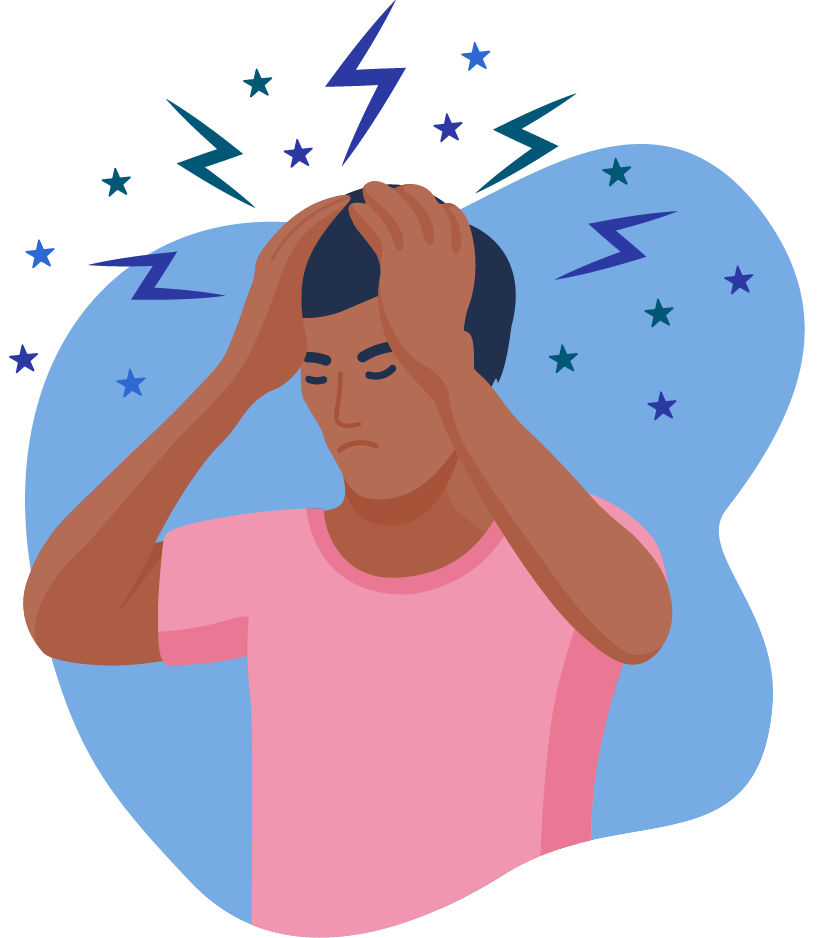
Quick Links
Resources
About MyMigraineTeam
Powered By






A vestibular migraine is a neurological condition in which a person experiences migraine-associated vertigo (a spinning sensation), imbalance, nausea, or vomiting, either with or without a headache. Vestibular migraine attacks are also known as migrainous vertigo, migraine-related dizziness, and migraine with prominent vertigo.

Not sure if you have migraine? Take the 2-minute assessment.
Vestibular migraine may affect as much as 1 percent of the population, and these migraine attacks are the most common cause of episodic vertigo. This type of migraine affects far more women than men, with a gender ratio of 5 to 1.
Symptoms of vestibular migraine include a combination of migraine-related symptoms and vestibular-related symptoms (symptoms related to your sense of balance and perception of your body). However, symptoms do not have to occur at the same time — migraine symptoms tend to appear earlier than vestibular symptoms when this condition first arises.
Symptoms of a migraine include:
Vestibular migraine symptoms also include:
The biggest difference between vestibular migraine and other migraine types is that vestibular migraine does not always have the severe head pain that is so closely associated with regular migraine attacks.
The causes of vestibular migraine attacks are largely unknown. However, vestibular migraine attacks (like other migraine types) do tend to run in families, which suggests that there is a strong genetic component. Because of possible heredity, it’s important to tell your doctor about any family history of migraine disorders.
A family doctor can be helpful in coming to a medical conclusion about conditions such as migraine, but an official diagnosis of vestibular migraine will typically come from a neurologist (a specialist in neurological symptoms).
It may be difficult to diagnose vestibular migraine because the migraine symptoms do not always occur alongside the vestibular symptoms. In fact, “vestibular migraine” was not always its own diagnosis. Now, the Bárány Society and the International Headache Society have settled on the following diagnostic criteria for vestibular migraine:
A person must also experience one or more of the following migraine features with at least half of their vestibular episodes:
A doctor usually looks at several years of headache and vestibular symptoms history before coming to a diagnosis.
There are other vestibular disorders that can present similarly to vestibular migraine. These include:
It is also possible for these conditions to be comorbid (co-occurring) with vestibular migraine, which can further complicate getting a proper diagnosis.
Vestibular migraine attacks are treated similarly to other migraine attacks, with pain-relieving or pain prevention medications. For instance, prescription medications called triptans — such as Imitrex (sumatriptan) and Maxalt (rizatriptan) — are often used to treat migraine because they block pain pathways in the brain. A newer drug, Reyvow (lasmiditan), has also been approved for the treatment of migraine with or without aura.
If episodes of vestibular migraine are frequent, the following treatments may also be suggested.
Beta blockers are used to help prevent migraine attacks. These drugs block beta-adrenergic activity, meaning they prevent the actions of epinephrine (adrenaline) and help relax blood vessels. Examples of beta blockers include Inderal (propranolol) and Blocadren (timolol).
Calcium channel blockers are also used to help prevent migraine attacks. These drugs prevent calcium from entering the cells of your heart and arteries, which prevents contraction of the muscle wall of the artery. An example of a calcium channel blocker is Norvasc (amlodipine).
Antidepressants such as selective serotonin reuptake inhibitors or serotonin norepinephrine reuptake inhibitors may be used to help prevent migraine attacks. These medications are believed to work by changing serotonin levels in the brain, although their efficacy has been disputed. Tricyclic antidepressants may be more helpful. Examples of tricyclic antidepressants include Elavil (amitriptyline) and Pamelor (nortriptyline).
Sometimes medications typically used for seizures, such as Topamax (topiramate), can also be used to prevent migraine attacks.
MyMigraineTeam is the social network for people with migraine and their loved ones. More than 72,500 people come together to share stories, give advice, and discuss their experiences with other people who understand living with migraine.
Have you or a loved one been diagnosed with vestibular migraine? Comment below, or join the conversation at MyMigraineTeam.

Are your headaches a symptom of migraine? Get a quick assessment.
I Was Prescribed Aimovig For Vestibular Migraine. Reluctant To Start. What Do You Think
Sign up for free!
Become a member to get even more




A MyMigraineTeam Member
I was diagnosed by a neurologist with vestibular migraines. From what I’ve been reading here confirms my doc is on the right track. Triggers are sunshine, barometric pressure, lack of sleep and… read more